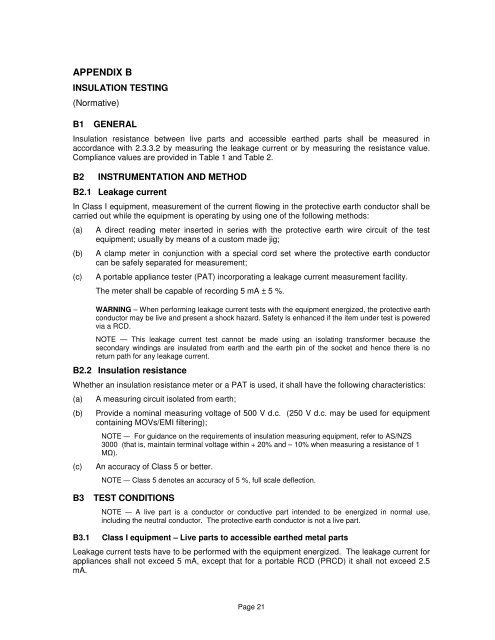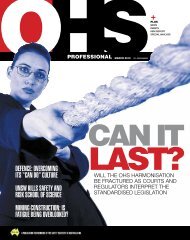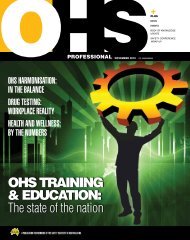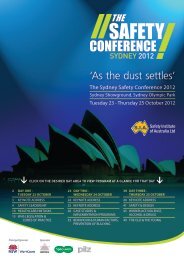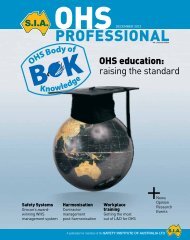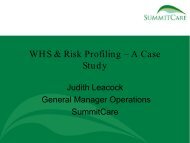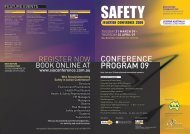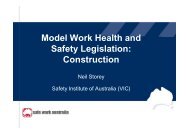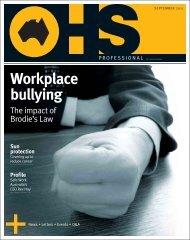In-service safety inspection and testing of electrical equipment
In-service safety inspection and testing of electrical equipment
In-service safety inspection and testing of electrical equipment
You also want an ePaper? Increase the reach of your titles
YUMPU automatically turns print PDFs into web optimized ePapers that Google loves.
APPENDIX BINSULATION TESTING(Normative)B1 GENERAL<strong>In</strong>sulation resistance between live parts <strong>and</strong> accessible earthed parts shall be measured inaccordance with 2.3.3.2 by measuring the leakage current or by measuring the resistance value.Compliance values are provided in Table 1 <strong>and</strong> Table 2.B2INSTRUMENTATION AND METHODB2.1 Leakage current<strong>In</strong> Class I <strong>equipment</strong>, measurement <strong>of</strong> the current flowing in the protective earth conductor shall becarried out while the <strong>equipment</strong> is operating by using one <strong>of</strong> the following methods:(a)(b)(c)A direct reading meter inserted in series with the protective earth wire circuit <strong>of</strong> the test<strong>equipment</strong>; usually by means <strong>of</strong> a custom made jig;A clamp meter in conjunction with a special cord set where the protective earth conductorcan be safely separated for measurement;A portable appliance tester (PAT) incorporating a leakage current measurement facility.The meter shall be capable <strong>of</strong> recording 5 mA ± 5 %.WARNING – When performing leakage current tests with the <strong>equipment</strong> energized, the protective earthconductor may be live <strong>and</strong> present a shock hazard. Safety is enhanced if the item under test is poweredvia a RCD.NOTE — This leakage current test cannot be made using an isolating transformer because thesecondary windings are insulated from earth <strong>and</strong> the earth pin <strong>of</strong> the socket <strong>and</strong> hence there is noreturn path for any leakage current.B2.2 <strong>In</strong>sulation resistanceWhether an insulation resistance meter or a PAT is used, it shall have the following characteristics:(a)(b)(c)A measuring circuit isolated from earth;Provide a nominal measuring voltage <strong>of</strong> 500 V d.c. (250 V d.c. may be used for <strong>equipment</strong>containing MOVs/EMI filtering);NOTE — For guidance on the requirements <strong>of</strong> insulation measuring <strong>equipment</strong>, refer to AS/NZS3000 (that is, maintain terminal voltage within + 20% <strong>and</strong> – 10% when measuring a resistance <strong>of</strong> 1M).An accuracy <strong>of</strong> Class 5 or better.NOTE — Class 5 denotes an accuracy <strong>of</strong> 5 %, full scale deflection.B3 TEST CONDITIONSNOTE — A live part is a conductor or conductive part intended to be energized in normal use,including the neutral conductor. The protective earth conductor is not a live part.B3.1 Class I <strong>equipment</strong> – Live parts to accessible earthed metal partsLeakage current tests have to be performed with the <strong>equipment</strong> energized. The leakage current forappliances shall not exceed 5 mA, except that for a portable RCD (PRCD) it shall not exceed 2.5mA.Page 21


